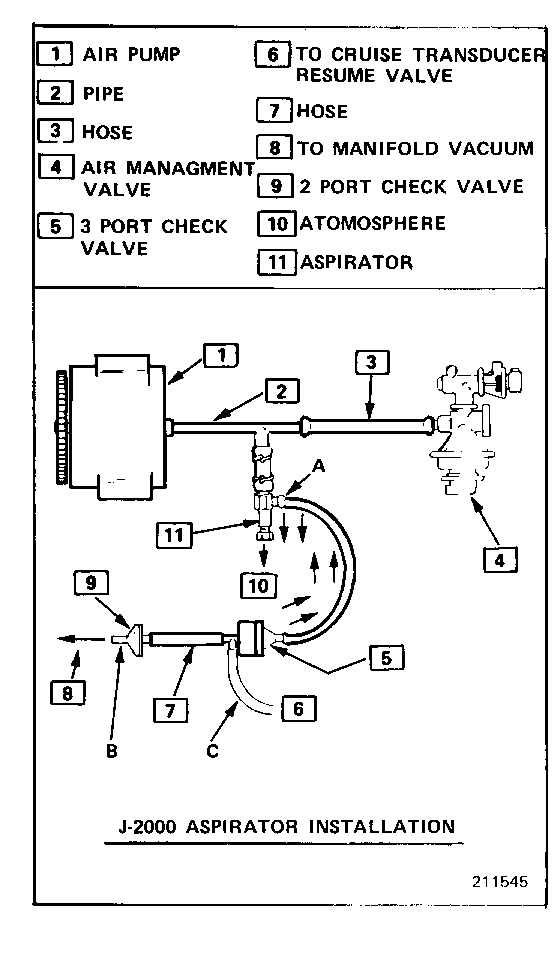CRUISE CONTROL OPERATION REVISED DIAGNOSIS INFORMATION

Subject: 1982 J2000 CRUISE CONTROL
1982 J2000 models utilize an aspirator assisted vacuum system for cruise control operation. It supplements engine vacuum when engine vacuum is low such as going uphill or when the engine is under load. The system is shown schematically in Figure 1 (see page 3).
The system consists of an aspirator, a 3-port check valve, a 2-port check valve and related components such as the air pump and air management valve. The air for the aspirator is tapped off the airline that connects the air pump to the air management valve. Connecting hoses connect these components together. The lower tee of the 3-port check valve leads to the resume valve while a hose from the manifold side of the 2-port check valve leads to the intake manifold.
The system performs as follows:
o Under normal vacuum conditions, air is bled into the system in the direction shown by the single arrow, that is, from the transducer resume valve to lower "T" of the 3-port check valve, then to the 2-port check valve, finally into the intake manifold.
o Also, during normal operation, as the air pump is pumping air to the air management valve, a small amount is diverted through the aspirator to the atmosphere. As it passes through the aspirator, a venturi-action inside the aspirator assembly develops a vacuum. This vacuum is used to provide the vacuum assist needed under high load cruise conditions.
o Should manifold vacuum fall below aspirator vacuum, the 2-port check valve is designed to close while the 3-port check valve is designed to open. Opening of the 3-port check valve exposes the higher vacuum at the aspirator thus providing the needed vacuum to provide proper cruise function. At this time air flow is in the direction shown by the double arrow.
Note that the check valves are arrowhead shaped in the direction of air flow to eliminate installation error.
To determine if the entire system is operative, proceed as follows:
STEP 1: First make sure all hoses and connections are secure. Make sure check valves are correctly positioned.
STEP 2: Connect a vacuum gage to the aspirator output at Point A.
STEP 3: Run engine at 2,500 RPM. Engine should be warmed up to ensure that computer command control system is running in closed loop. (Check with dwell meter.)
STEP 4: Observe vacuum gage. A minimum of 6 inches should be shown.
If not, clean aspirator with mineral solvent and recheck. If required, replace aspirator, also check air pump for output. If none, service air pump. If no defect is shown, go to Step 5.
STEP 5: Disconnect vacuum gage at Point A. Plug 2-port check valve at Point B. Blow air into the resume valve hose at Point C. Air should move through and exit at Point A indicating free flow in this direction.
STEP 6: Remove plug from 2-port check valve at Point B. Plug hose at Point A.
Blow air into cruise resume valve hose at Point C, air should exit at port B.
Steps 5 and 6 determine if the hoses and check valves are functioning in one direction. To check for operation in the other direction, go to Step 7.
STEP 7: Blow air first into hose at Point A while port B is plugged, then into the hose at port B while hose at Point A is plugged.
No air should exist at Point C in either case. Replace components as required.
Dealer installed cruise control packages are available from WDDGM. Part numbers are:
997815 - Manual Transmission 997816 - Automatic Transmission

General Motors bulletins are intended for use by professional technicians, not a "do-it-yourselfer". They are written to inform those technicians of conditions that may occur on some vehicles, or to provide information that could assist in the proper service of a vehicle. Properly trained technicians have the equipment, tools, safety instructions and know-how to do a job properly and safely. If a condition is described, do not assume that the bulletin applies to your vehicle, or that your vehicle will have that condition. See a General Motors dealer servicing your brand of General Motors vehicle for information on whether your vehicle may benefit from the information.
